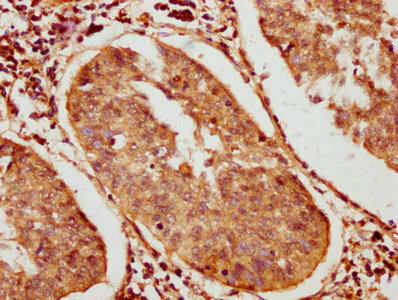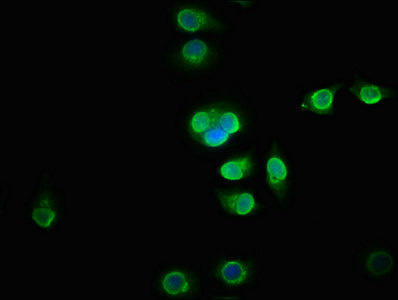Description
| Antibody Name: | BICC1 Antibody (PACO61454) |
| Antibody SKU: | PACO61454 |
| Size: | 50ug |
| Host Species: | Rabbit |
| Tested Applications: | ELISA, IHC, IF |
| Recommended Dilutions: | ELISA:1:2000-1:10000, IHC:1:200-1:500, IF:1:50-1:200 |
| Species Reactivity: | Human |
| Immunogen: | Recombinant Human Protein bicaudal C homolog 1 protein (682-849AA) |
| Form: | Liquid |
| Storage Buffer: | Preservative: 0.03% Proclin 300 Constituents: 50% Glycerol, 0.01M PBS, pH 7.4 |
| Purification Method: | >95%, Protein G purified |
| Clonality: | Polyclonal |
| Isotype: | IgG |
| Conjugate: | Non-conjugated |
 | IHC image of PACO61454 diluted at 1:400 and staining in paraffin-embedded human cervical cancer performed on a Leica BondTM system. After dewaxing and hydration, antigen retrieval was mediated by high pressure in a citrate buffer (pH 6.0). Section was blocked with 10% normal goat serum 30min at RT. Then primary antibody (1% BSA) was incubated at 4°C overnight. The primary is detected by a biotinylated secondary antibody and visualized using an HRP conjugated SP system. |
 | Immunofluorescence staining of A549 cells with PACO61454 at 1:133, counter-stained with DAPI. The cells were fixed in 4% formaldehyde, permeabilized using 0.2% Triton X-100 and blocked in 10% normal Goat Serum. The cells were then incubated with the antibody overnight at 4°C. The secondary antibody was Alexa Fluor 488-congugated AffiniPure Goat Anti-Rabbit IgG(H+L). |
| Background: | Putative RNA-binding protein. Acts as a negative regulator of Wnt signaling. May be involved in regulating gene expression during embryonic development. |
| Synonyms: | Protein bicaudal C homolog 1, Bic-C, BICC1 |
| UniProt Protein Function: | BICC1: Putative RNA-binding protein. Acts as a negative regulator of Wnt signaling. May be involved in regulating gene expression during embryonic development. Defects in BICC1 are a cause of susceptibility to renal dysplasia, cystic (CYSRD). An anomaly of the kidney characterized by numerous renal cysts and apparent disorder of differentiation of the renal parenchyma. Kidney of affected individuals lack the normal renal bean shape, and the collection drainage system. The cystic, dysplastic kidney contains undifferentiated mesenchyme, cartilaginous tissue, and immature collecting ducts. Belongs to the BicC family. 2 isoforms of the human protein are produced by alternative splicing.Protein type: RNA-bindingChromosomal Location of Human Ortholog: 10q21.1Disease: Renal Dysplasia, Cystic, Susceptibility To |
| UniProt Protein Details: | |
| NCBI Summary: | This gene encodes an RNA-binding protein that is active in regulating gene expression by modulating protein translation during embryonic development. Mouse studies identified the corresponding protein to be under strict control during cell differentiation and to be a maternally provided gene product. [provided by RefSeq, Apr 2009] |
| UniProt Code: | Q9H694 |
| NCBI GenInfo Identifier: | 119367815 |
| NCBI Gene ID: | 80114 |
| NCBI Accession: | Q9H694.2 |
| UniProt Secondary Accession: | Q9H694,Q99MQ1, Q5U4T7, Q9IA00 |
| UniProt Related Accession: | Q9H694 |
| Molecular Weight: | 94,288 Da |
| NCBI Full Name: | Protein bicaudal C homolog 1 |
| NCBI Synonym Full Names: | BicC family RNA binding protein 1 |
| NCBI Official Symbol: | BICC1 |
| NCBI Official Synonym Symbols: | BICC; CYSRD |
| NCBI Protein Information: | protein bicaudal C homolog 1 |
| UniProt Protein Name: | Protein bicaudal C homolog 1 |
| UniProt Synonym Protein Names: | |
| Protein Family: | Protein bicaudal |
| UniProt Gene Name: | BICC1 |
| UniProt Entry Name: | BICC1_HUMAN |






